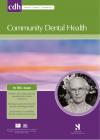Community Dental Health

- Cover Date:
- December 2011
- Print ISSN:
- 0265 539X
- Vol:
- 28
- Issue:
- 4
Applicability of both dentist and patient perceptions of dentists’ explanations to the evaluation of dentist–patient communication
Objectives: Very little is known about dentist–patient communicative behaviours in actual practice. This study evaluated dentist and patient perceptions of dentist–patient communication and patient outcome. Participants: The subjects were 171 dentist–patient pairs in Kitakyushu, Japan. Research design: Dentists and patients answered the same questionnaire items using the same response categories to evaluate dentist–patient communication. Based on the scores of patient and dentist perceptions with respect to dentist–patient communication, patient–dentist pairs were categorised into one of 3 groups. Data analyses used one-way ANOVA, multiple linear regression analysis, and multiple logistic regression analysis. Results: We found that, with respect to dentist–patient communication, patients in the ‘patient better’ group (i.e., the patient’s evaluation was more positive than the dentist’s evaluation) were more likely to have a positive outcome (e.g., ‘improvement of health and fear,’ ‘satisfaction with care’) than those in the other two groups. Patients in the ‘doctor better’ group (i.e., the dentist’s evaluation was the more positive) were more likely to have a negative outcome than those in the other two groups. Conclusions: A positive patient outcome is more likely when the patient’s evaluation is better than a dentist’s evaluation with respect to dentist–patient communicative behaviours. The method based on patient and dentist perceptions with respect to dentist–patient communication might be effective in evaluating dentist–patient communication.
Key words: patient satisfaction, communication behaviour, perception, Japan
- Article Price
- £15.00
- Institution Article Price
- £
- Page Start
- 274
- Page End
- 279
- Authors
- T. Hamasaki, I. Soh, T. Takehara, A. Hagihara
Articles from this issue
- Title
- Pg. Start
- Pg. End
- Why has oral health promotion and prevention failed children requiring general anaesthesia for dental extractions?
- 255
- 258
- Predictors of utilisation of dental care services in a nationally representative sample of adults
- 269
- 273
- Applicability of both dentist and patient perceptions of dentists’ explanations to the evaluation of dentist–patient communication
- 274
- 279
- Evaluation of a preventive program based on caries risk among mentally challenged children using the Cariogram model
- 286
- 291
- The effect of a modified fluoride toothpaste technique on buccal enamel caries in adults with high caries prevalence: a 2-year clinical trial
- 292
- 296
- Association of clinical oral health status with self-rated oral health and GOHAI in Japanese adults
- 297
- 300
- Prevalence of periodontopathogens in a black Brazilian secluded community matched with a black urban population
- 301
- 304
- Incisor trauma in a Turkish preschool population: Prevalence and socio-economic risk factors
- 308
- 312
- Malocclusion and orthodontic treatment need measured by the Dental Aesthetic Index and its association with dental caries in Indian schoolchildren
- 313
- 316
